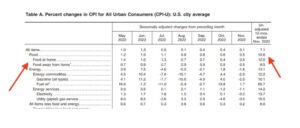Congress has quickly engaged in putting together potential aid packages for farmers that would more than double the Trump administration's $12 billion under the Farmer Bridge Assistance (FBA) Program.
Grocery Prices Increased 0.5% in November, Up 12% So Far This Year
Jeanna Smialek reported on the front page of today’s New York Times that, “Inflation slowed more sharply than expected in November, an encouraging sign for both Federal Reserve officials and consumers that 18 months of rapid and unrelenting price increases are beginning to meaningfully abate.

“The new data is unlikely to alter the Fed’s plan to raise interest rates by another half point at the conclusion of its two-day meeting on Wednesday.
“But the moderation in inflation, which affected used cars, some types of food and airline tickets, caused investors to speculate that the Fed could pursue a less aggressive policy path next year — potentially increasing the chances of a ‘soft landing,’ or one in which the economy slows gradually and without a painful recession.”
Today’s article added that, “Inflation remains unusually rapid for now: Tuesday’s 7.1 percent reading is an improvement, but it is still much faster than the roughly 2 percent that prevailed before the pandemic.
“The details of the report suggested that further cooling is likely in store.
“Many of the categories in which price increases are now slowing are tied more to the pandemic and supply chains than to Fed policy. For instance, food and fuel price jumps are moderating after climbing rapidly earlier this year, an effect of transportation issues and fallout from the war in Ukraine.”
Danielle Wiener-Bronner reported yesterday at CNN Online that, “In the year through November, food got 10.6% more expensive, with grocery prices rising 12% and menu prices jumping 8.5%, not adjusted for seasonal swings, the Bureau of Labor Statistics said Tuesday. In that same period, overall inflation rose 7.1%.”

The CNN article explained that, “A number of pantry and refrigerator staples continued to get more expensive last month, the latest data shows. Eggs, which have been affected by the deadly avian flu, were a staggering 49.1% more expensive through November, and butter prices, hit by a contraction in the milk supply, shot up 27%.
“Flour prices jumped 24.9%, bread went up 15.7%, milk was 14.7% more expensive and coffee prices rose 14.6%. Chicken was up 12% and fruits and vegetables spiked 9.7%.”
12 month percentage change, #Food Prices pic.twitter.com/bKWxcLIlKD
— FarmPolicy (@FarmPolicy) December 13, 2022
Bronner noted that, “Uncooked beef roasts fell 8.1%, and uncooked beef steaks dropped 7.4%. Pork roasts, steaks and ribs slipped 5.1%, and bacon ticked down 1.1%.
“Grocery and menu prices in November each went up 0.5% from the prior month, adjusted for seasonal swings.”
Writing on the front page of today’s Wall Street Journal, Gwynn Guilford reported that, “Grocery prices picked up 0.5% in November from the prior month, accelerating slightly from October’s pace, buoyed by increases in prices for bakery products and fruit and vegetables.”
12 month percentage change, #Food Prices pic.twitter.com/dyeAHhJdRh
— FarmPolicy (@FarmPolicy) December 13, 2022
Guliford added that, “Dining out—a service for which labor composes a relatively large share of costs—rose 0.5% in November from the prior month, a marked slowdown from the 0.9% average pace from June to October, as price gains for both sit-down meals and fast food eased.





